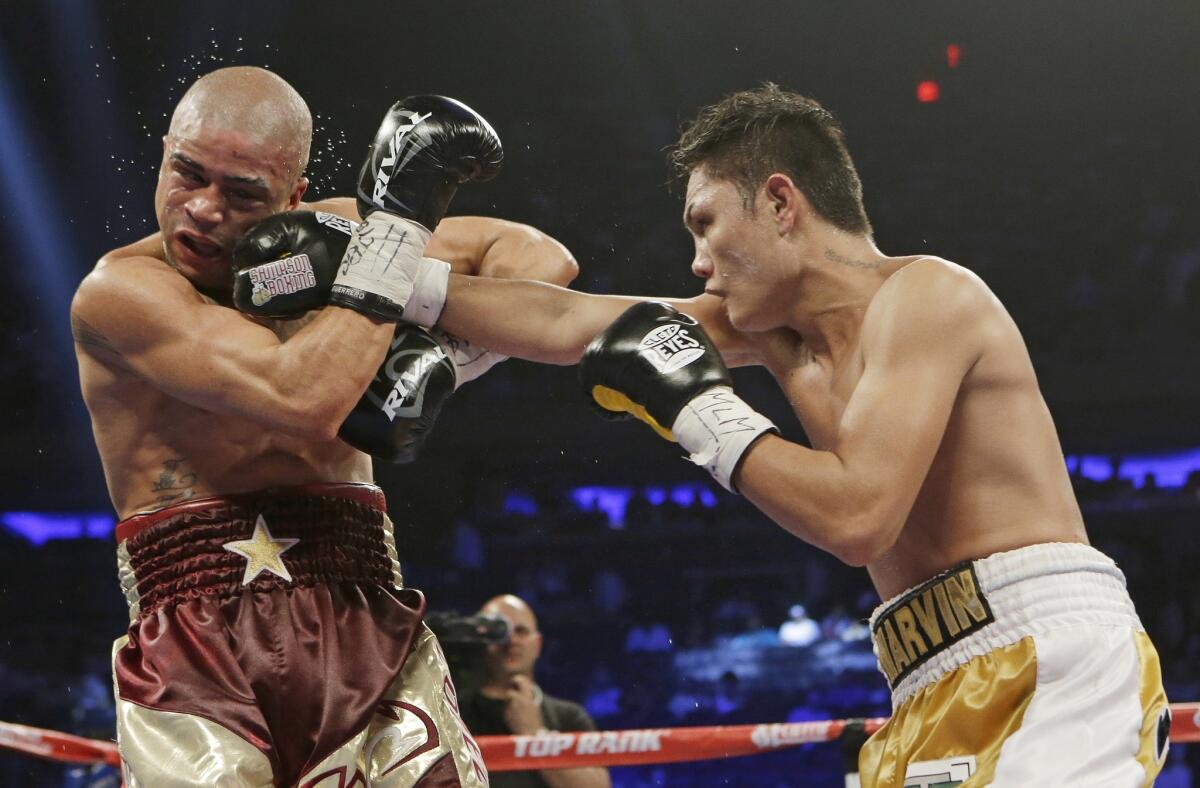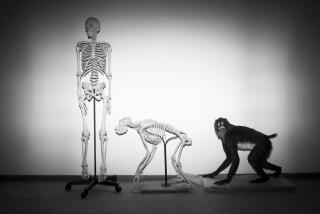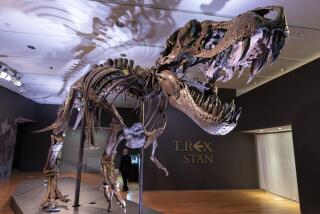Fight over fighting’s role in evolution enters round two

Did evolution hand man a face that’s fit to take a punch?
David R. Carrier, a University of Utah biologist who specializes in comparative biomechanics, believes that shortly after human-like primates stopped swinging from trees, they swung at each other. Our jaws, molars, cheeks, brows and other parts of the skull became more robust as a result of perennial fisticuffs, according to a study published this week in the journal Biological Reviews.
The theory already is sparking the same academic boxing match as did Carrier’s first parry, two years ago, when he and University of Utah physician Michael H. Morgan suggested the modern hand was more likely adapted for aggression than creativity. A longer and more flexible thumb, boxier palm and shorter digits changed pugilism from a flail-and-bite affair, common to apes, chimps and gorillas, to the jab-and-hook matches seen in the modern boxing ring, Carrier proposed.
Critics pointed out that the slim-boned hand of Homo sapiens isn’t so strong, and modern man’s face shows scant evidence that it adapted to defend against fists. Progressively slimmer brows, cheeks and jaws, in fact, only made modern man less able to take one on the kisser.
Carrier and Morgan took the punches, then took a look at research on the fossil record. Their review suggests that the face in two extinct branches of hominin, Australopithecus and Paranthropus, became more able to absorb and dissipate facial blows around the same time hands evolved. Those more robust characteristics also became more evident in males, the study suggests.
The researchers believe these changes cannot be explained fully by the prevailing theory that natural selection favored a skull, jaw and molars better suited for a diet of tough food, such as nuts and seeds.
“If you look at modern humans, there’s evidence that our muscles are stronger than what’s necessary for chewing,” Carrier said. “And the difference between males and females in the jaws and jaw muscles is the biggest problem the feeding hypothesis has.”
Why would there be such a difference if, as the fossil record suggests, males and females ate the same diet? In addition, the study notes, recent examination of the chemical composition and wear pattern of fossil teeth suggests the paleo diet wasn’t as tough to chew as previously thought.
Fist-first agression between males offers a better explanation for the gender difference in facial structure, which lingers in modern humans, Carrier said. “It’s a place where the feeding hypothesis clearly doesn’t provide an answer, whereas the buttressing hypothesis does,” he said.
Males who were better able to withstand blows to the face were more likely to survive battle, but also had a better chance of mating, Carrier said. That doesn’t mean ancient females preferred the heavy-browed, he added.
“These characteristics that make the face resistant to injury don’t necessarily make the male more attractive,” Carrier said. “What they do is allow other males and also females to judge that individual’s strength and fighting ability.”
Carrier and Morgan do pull some punches in this round.
“In most cases it’s probably a number of selective factors that have been working that have been influential,” Carrier said. “There’s no doubt that there are aspects of feeding that have influenced the face of hominins. But in addition to that, there’s also strong evidence to suggest that the face has been influenced by selection based on aggressive behavior.”
Critics, however, think Carrier and Morgan are just being hard-headed.
“What I find most objectionable is that this type of research does a disservice to the general public by supplying a very wrong understanding of human biology, and more generally, human evolution,” said David C. Nickle, an evolutionary biologist at Merck Research Laboratories in West Point, Pa.
Matching traits to circumstances in the environment is not enough to prove there was evolutionary pressure behind what appears to be an adaptation, Nickle and others caution. Some adaptive traits can be little more than happy coincidences of another change – smaller canines and stronger molars that aided a broader diet could have created the more robust jaw, while other craniofacial changes could have tagged along with selection that favored a bigger brain, for instance.
“Heads that evolved to withstand impact can be seen in animals such as the bighorn sheep, not in humans,” Nickle said. “I think Carrier and Morgan’s argument is akin to arguing that human speech evolved so that humans could more effectively lie to each other.”







